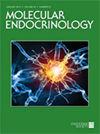Irisin Is Regulated by CAR in Liver and Is a Mediator of Hepatic Glucose and Lipid Metabolism.
Q Biochemistry, Genetics and Molecular Biology
引用次数: 68
Abstract
Irisin, a hormone proteolytically processed from fibronectin type III domain-containing protein 5 (FNDC5), has been reported to induce the browning of sc adipocytes by increasing the level of uncoupling protein 1. In this study, we showed that activation of the nuclear receptor constitutive androstane receptor induced FNDC5 mRNA expression in the liver and increased the circulating level of irisin in mice. FNDC5/irisin is a direct transcriptional target of constitutive androstane receptor. Hepatic-released irisin functioned as a paracrine/autocrine factor that inhibited lipogenesis and gluconeogenesis via the Adenosine 5'-monophosphate (AMP)-activated protein kinase pathway. Adenovirus-overexpressed irisin improved hepatic steatosis and insulin resistance in genetic-induced obese mice. Irisin transgenic mice were also protected against high-fat diet-induced obesity and insulin resistance. In conclusion, our results reveal a novel pathway in regulating FNDC5/irisin expression and identify a physiological role for this hepatic hormone in glucose and lipid homeostasis.鸢尾素受肝内CAR调控,是肝脏糖脂代谢的介质。
鸢尾素是一种由纤维连接蛋白III型结构域蛋白5 (FNDC5)水解而成的激素,据报道,鸢尾素通过增加解偶联蛋白1的水平,诱导sc脂肪细胞褐变。在本研究中,我们发现激活核受体组成雄烷受体可诱导小鼠肝脏中FNDC5 mRNA的表达,并增加鸢尾素的循环水平。FNDC5/鸢尾素是组成型雄甾受体的直接转录靶点。肝释放的鸢尾素作为一种旁分泌/自分泌因子,通过腺苷5'-单磷酸(AMP)激活的蛋白激酶途径抑制脂肪生成和糖异生。腺病毒过表达的鸢尾素改善了遗传性肥胖小鼠的肝脏脂肪变性和胰岛素抵抗。鸢尾素转基因小鼠也可以防止高脂肪饮食引起的肥胖和胰岛素抵抗。总之,我们的研究结果揭示了调控FNDC5/鸢尾素表达的新途径,并确定了这种肝脏激素在葡萄糖和脂质稳态中的生理作用。
本文章由计算机程序翻译,如有差异,请以英文原文为准。
求助全文
约1分钟内获得全文
求助全文
来源期刊

Molecular endocrinology
医学-内分泌学与代谢
CiteScore
3.49
自引率
0.00%
发文量
0
审稿时长
12 months
期刊介绍:
Molecular Endocrinology provides a forum for papers devoted to describing molecular mechanisms by which hormones and related compounds regulate function. It has quickly achieved a reputation as a high visibility journal with very rapid communication of cutting edge science: the average turnaround time is 28 days from manuscript receipt to first decision, and accepted manuscripts are published online within a week through Rapid Electronic Publication. In the 2008 Journal Citation Report, Molecular Endocrinology is ranked 16th out of 93 journals in the Endocrinology and Metabolism category, with an Impact Factor of 5.389.
 求助内容:
求助内容: 应助结果提醒方式:
应助结果提醒方式:


